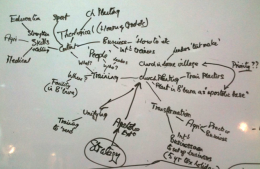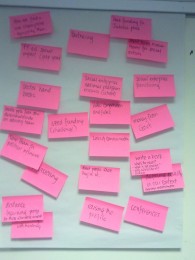 Furniture!
Furniture!
The layout and comfort of chairs are key contributors to the success of a meeting! Yet they are often neglected. This is true of a church meeting as well as of meetings of elders, trustees etc. For instance, prayer and participation in ‘body ministry’ is greatly helped by people being able to see each other – a circle or ‘horseshoe’ – rather than praying into the back of the head of someone in front of you! An elders’ or trustees’ meeting can be more effective around a table where there is space for papers and laptops than in relaxed easy chairs. It also brings a helpful ‘formality’ to the meeting.
The same is also true for group discussions of the type we are considering in this series. It is the responsibility of the facilitator to think through what layout will be most conducive to achieving good outcomes.
Hours together
It is likely that the group will be together for several hours. So the environment should allow people to move around. It may well be that the facilitator will break the group into smaller discussion groups (as illustrated in the last blog posting) so there needs to be space for 2 or 3 circles of people, perhaps around tables.
Don’t forget the atmosphere! Make sure there is good ventilation and sufficient light levels. It sounds obvious, but can easily be forgotten.
Displays
 It is likely that flip charts or equivalent will be needed and so not only do you need a flip chart easel in a viewable position but also walls to attach completed sheets to so that they can be seen as the discussion progresses.
It is likely that flip charts or equivalent will be needed and so not only do you need a flip chart easel in a viewable position but also walls to attach completed sheets to so that they can be seen as the discussion progresses.
What about phones?
These are the bane of good discussion! They need to be turned off. To see some members surreptitiously sending texts ‘under the table’ is not only discourteous to the other members of the group but it also means that that person is not participating fully in the discussion.
Recording
 It is vital to capture all salient points that may be made during the discussion. A full record of the discussion is not necessary as it evolves over the period. But any key suggestions should be noted and agreed actions recorded. This may be by an individual member of the group or it may be achieved through the use of Post-its and Flip chart sheets. But the Facilitator must think through in advance how this information is to be captured and how it will be used after the session is over. We shall consider this in greater depth in another blog.
It is vital to capture all salient points that may be made during the discussion. A full record of the discussion is not necessary as it evolves over the period. But any key suggestions should be noted and agreed actions recorded. This may be by an individual member of the group or it may be achieved through the use of Post-its and Flip chart sheets. But the Facilitator must think through in advance how this information is to be captured and how it will be used after the session is over. We shall consider this in greater depth in another blog.
Next time we shall conclude this series by considering the role of the facilitator and the preparation needed to achieve a successful outcome.
